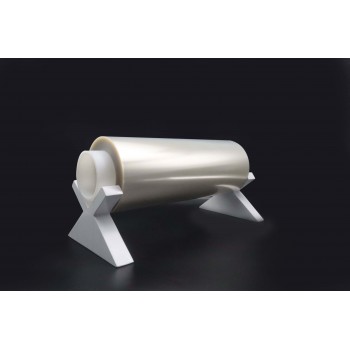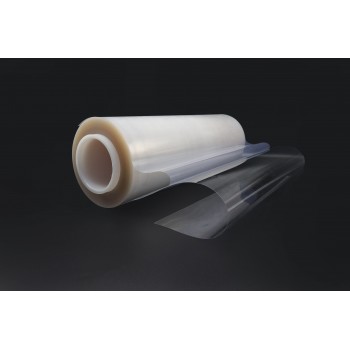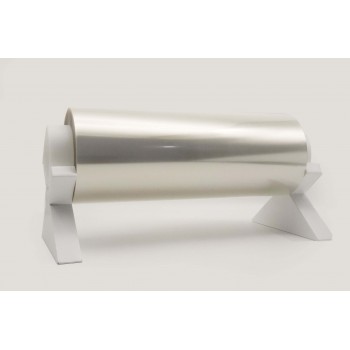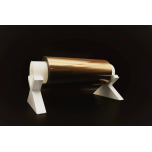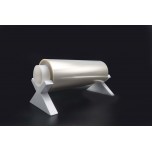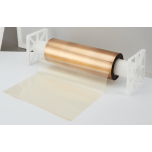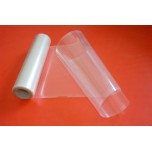ePTFE Reinforced PFSA Membrane (9 microns thick, Pt impregnated) for PEM Fuel Cells
ePTFE Reinforced PFSA Membrane (9 microns thick, Pt impregnated) for PEM Fuel Cells is used to separate the anode and cathode compartment of PEM fuel cell stacks that usually consume H2/Air as the fuel/oxidant and requires achieving high current densities (which necessitates the use of a relatively thin membrane). It is quite a common practice in the fuel cell industry to use reinforced PFSA membranes with a thickness of 50 microns or less for most of the commercial applications (such as PEM fuel cell stacks for automotive, heavy duty trucks, buses, electrified mobility, drones, UAVs, etc.). This mechanically reinforced PFSA membrane has a thickness of ~9 microns and ideally suited for PEM fuel cell stacks that would yield very high current densities and long operational lifetimes. The mechanical reinforcement in this membrane is based on the microporous ePTFE which has 3-D porous regions where the ionically conducting PFSA is wet impregnated via solution cast method. Platinum impregnation to one face of the membrane significantly reduced the H2 gas crossover since platinum nanoparticles would function as a recombination catalyst where diffusing H2 molecules would be converted to water molecules. Considering ePTFE Reinforced PFSA Membrane (9 microns thick, Pt impregnated) for PEM Fuel Cells will broaden researchers horizon by providing an equally valuable avenue to explore, alongside Nafion HP and Nafion XL membranes and several other ePTFE reinforced membrane that were golden standard in the industry in the past and have been discontinued as a result in the market shift.
The major benefit of mechanically reinforced PFSA membranes would be their significantly enhanced operational lifetime compared to the unreinforced PFSA membranes due to swelling related stresses being taken up by the ePTFE reinforcement. One of the major limitations of the mechanically reinforced PFSA membranes is their lower proton or ionic conductivity compared to unreinforced membranes because of less ionically conducting material per unit volume or per unit mass (while ePTFE reinforcement is quite porous, it does have a mass regardless). While it is not a common practice, this membrane product can also be used in electrochemical sensors and other relevant technologies that would have a need for thin and mechanically reinforced proton exchange membrane for its operation.
ePTFE Reinforced PFSA Membrane (9 microns thick, Pt impregnated) for PEM Fuel Cells is based on the chemically stabilized perfluorosulfonic acid material and it is shipped in the acid (H+) form (which is also known as protonic form). Chemical stabilization is also known as end-group stabilization where the carbon atoms that end of the PFSA polymer chains are fully fluorinated. Chemically stabilized PFSA membranes will exhibit substantially lower fluoride ion release compared to the PFSA membranes manufactured from unstabilized PFSA resin. Functional groups (also known as sulfonic acid sites) for this PFSA membrane are based on the long side chain for its chemical structure.
Proton exchange membranes are also known as cation exchange membranes in the market. This PFSA membrane performs as a separator and solid electrolyte (without the need of a liquid acid) in a variety of electrochemical cells that require the membrane to selectively transport protons or other various cations across the cell junction (or between anode and cathode catalyst layers). The polymer is chemically resistant and durable.
This membrane has a cover film on one face in order to protect the membrane during shipping. Platinum impregnation is done on the face that is away from the cover film. For best utilization of the Pt impregnation from the membrane manufacturer, it is recommended that the Pt side is placed toward the anode of the electrolyzer cell (cathode of the fuel cell) electrochemical cell. This Pt impregnation is actually a Pt nanopowder that is incorporated into the entire surface of the membrane on the side opposite the single backing. This platinum layer is not sufficient to sustain the electrochemical reactions of the cells, it is only intended to react the minute crossover gases that occur naturally in all membranes. This membrane is ready for use as it is shipped and requires no pretreatment steps.
Please contact us at sales@fuelcellstore.com for the SDS and technical data sheets (TDS).
| Membrane Properties | |
| Thickness | 9±1 micrometers (per GB/T20043.2022) |
| Conductivity (S/cm) | > 0.035 S/cm (or ≥ 35 mS/cm) |
| Modulus (MPa) | > 250 / 250 MPa (MD/TD) (per GB/T20043.2022) |
| Tensile Strength - max. (MPa) | > 40 / 40 MPa (MD/TD) (per GB/T20043.2022) |
| Elongation to Break (%) | > 100% / 100% (MD/TD) (per GB/T20043.2022) |
| Membrane Hydrolytic Properties | |
| Water content (% water) | 5±3%, 5±3% (MD/TD) (per GB/T20043.2022) |
| Linear Expansion | <5%, <5% (MD/TD) (per GB/T20043.2022) |
Write a review
Your Name:
Your Review: Note: HTML is not translated!
Rating: Bad Good
Enter the code in the box below:






